How to Keep your Baby’s Feet Healthy – Follow These 3 Simple Steps!
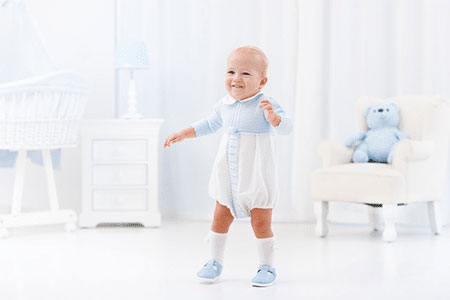
Did you know that babies who don’t wear the correct types of shoes are at higher risk of developing several foot issues as well as foot, leg, and back problems in the future? Parents need to understand that the foot of a baby is soft and pliable because the bones are not yet completely formed. I am going to show you how to keep your baby’s feet healthy based on my many years of shoe fitting experience.
It’s important to take proper care of your babies’ feet from an early stage, and taking proper care of your babies’ feet starts with providing your baby with the correct shoes in the correct shoe size.
I have fitted hundreds of babies for their first pair of shoes which has helped me become familiar with the best baby shoe brands and the best styles among those brands. By providing your baby with the correct pair of shoes you will prevent foot infections, blisters, calluses, corns, as well as general foot and leg pain.
I will show you exactly which shoes are better for your baby depending on your baby’s foot shape, and I will also show you how to make sure that you provide your baby with the correct shoe size.
If you’re pressed for time, you can jump directly to the selection of the best baby shoes.
How to Keep Your Baby’s Feet Healthy
These are the 3 factors that play a key role in keeping your baby’s feet healthy:
1️⃣ Shoes: Parents are often overwhelmed with the myriad of baby shoe options. Most of the time they find themselves staring at a wall of shoes that look very similar and very different at the same time. Your baby shoes need to provide protection, flexibility, and sensory pods. In addition, the shoes need to fit your baby’s foot shape which can be narrow, medium, wide, or extra wide.
2️⃣ Socks: Certain baby socks are better than others in terms of fit and quality of the materials. Some socks are made of softer and more breathable materials. Seamless socks are also great for keeping babies’ feet comfortable and healthy.
3️⃣ Washing and Drying: Please make sure that you always wash and dry your babies’ feet thoroughly.
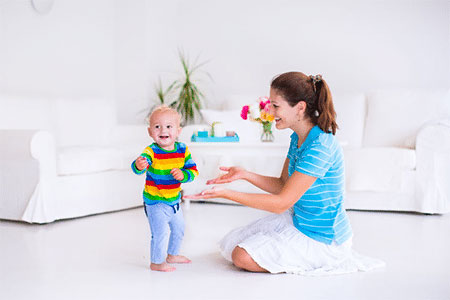
First Step: Wearing the Correct Type of Shoes
The first step in keeping babies’ feet healthy involves providing them with the correct pair of shoes. In addition to providing your baby with shoes that emulate barefoot walking, you need to make sure that you provide your baby with the correct shoe size, which involves getting the correct shoe length and the correct shoe width.
Most babies won’t be able to speak up when their shoes feel too tight, so you must be proactive and check your babies’ feet and shoes regularly.
Let me show you why the shoes I recommend are the most effective ones in keeping your baby’s feet healthy:
Babies’ Shoes – Sensory Pods, Lightweight, Flexible, and Extra Depth!
Babies who are learning how to walk need to go barefoot as often as possible for healthy foot development. Shoes start to play a role when you take your baby outside, and they mainly serve as a means of protection. Your baby’s shoes should emulate barefoot walking, and there are 5 key features that they need to provide:
1️⃣ Sensory Pods: This feature allows babies to get a better feeling of the ground, which makes babies feel more confident when taking those first steps.
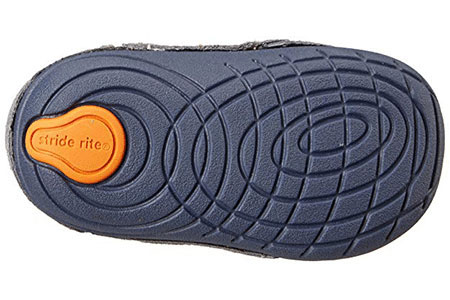
2️⃣ Lightweight and Flexible: Babies don’t have the power thrust to bend a harder sole, so your babies’ shoes need to be as lightweight and flexible as possible.
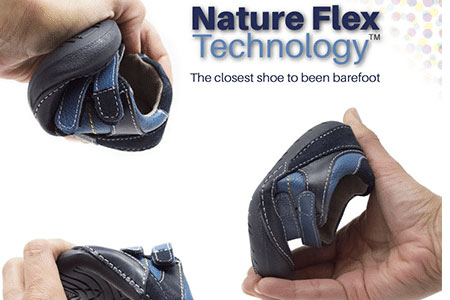
3️⃣ Extra Depth: This feature allows your babies’ feet to fit deeply inside the shoes, which helps prevent the top part of your babies’ feet and toes from rubbing against the top part of the shoes. Most babies tend to have wide or extra wide feet, since they might still carry some fat pad on the bottom of their feet.
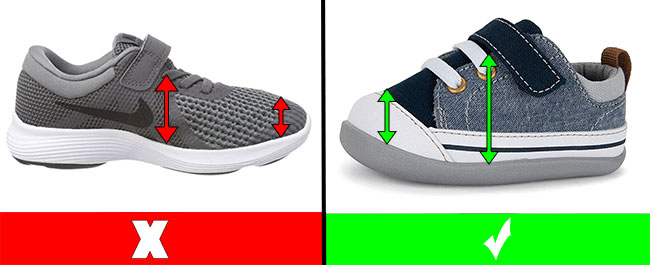
4️⃣ Rounder Toe-Box: This feature helps prevent your babies’ toes from rubbing against one another or the side of the shoes.

5️⃣ Available in Different Widths: Most babies have wide to extra wide feet, so the shoes need to be available in different widths to be able to accommodate the shape of your babies’ feet.
Below you can find a selection of the best babies’ shoes that I have fitted before. Disclosure: Some links in this post may be affiliate links and we may receive a small commission (at no extra cost to you) when you click our links and make purchases.
The Best Baby Shoes
These shoes are available in different width such as medium (M), wide (W), and extra wide (XW).
Boys
- Shoe style SRT SM Artie by Stride Rite
- Available in medium, wide, and extra wide widths
- Rounded edges to decrease stumbles and falls
- APMA approved and built for first-time walkers
- Order this shoe a whole size larger than your baby’s current foot size
- Shoe style 2510 Racer by Tsukihoshi
- Fits medium and wide feet
- Heel stabilizer provides lateral stability
- Removable insoles
- Machine washable
- Order this shoe the same size as your baby’s foot size (shoe fits long)
- Shoe style Wes by Stride Rite
- Available in medium, wide, and extra wide widths
- Seamless construction cradle the baby’s natural shape
- Flexible, rounded, slip-resistant soles
- APMA approved
- Order this shoe a whole size larger than your baby’s current foot size
- Shoe style SM Adamby Stride Rite
- Available in medium and wide widths
- Seamless construction cradle the baby’s natural shape
- Flexible, rounded, slip-resistant soles
- Foam padding placed around the ankle collar and under the tongue for an incredibly comfortable fit and feel
- Order this shoe a whole size larger than your baby’s current foot size
- Shoe style Stevie II by See Kai Run
- Fits medium and wide feet
- Rubber outsole is flexible yet durable and provides the needed traction for first steps
- Padded heel and tongue keeps the baby’s feet comfortable
- Wide openings make on and off quick and easy
- Order this shoe half a size larger than your baby’s current foot size
- Shoe style Martin by Stride Rite
- Available in medium and wide widths
- Seamless construction cradle the baby’s natural shape
- Flexible, rounded, slip-resistant soles
- Oversized opening and pull tab on the back offer easy on and off
- Order this shoe a whole size larger than your baby’s current foot size
- Shoe style Kennedy by Stride Rite
- Available in medium, wide, and extra wide widths
- Seamless construction that cradles the foot’s natural shape
- APMA approved
- Oversized opening for easy-on
- Order this shoe half a size larger than your baby’s current foot size
- Shoe style SM Zip Runner by Stride Rite
- Available in medium and wide widths
- Oversized opening for easy on and off
- Flexible, rounded, slip-resistant soles encourage natural motion and help improve balance
- Machine washable
- Order this shoe a whole size larger than your baby’s current foot size
- Shoe style SRT Elliot by Stride Rite
- Available in medium, wide, and extra wide widths
- 100% leather made
- Sensory pods to feel the ground beneath for better traction and grip
- Lace-up closure
- Order this shoe a whole size larger than your baby’s current foot size
Girls
- Shoe style SM Adalyn by Stride Rite
- Available in medium, wide, and extra wide widths
- Oversized opening for easy on and off
- Flexible, rounded, slip-resistant soles encourage natural motion and help improve balance
- APMA approved
- Order this shoe a whole size larger than your baby’s current foot size
- Shoe style Zips Runner by Stride Rite
- Available in medium, wide, and extra wide widths
- Oversized opening for easy on and off
- Padded tongue and collar
- APMA approved
- Order this shoe a whole size larger than your baby’s current foot size
- Shoe style Susie Mary Jane by See Kai Run
- Fits medium and wide feet
- Black patent leather upper with full leather lining and insole
- Awarded the Seal of Acceptance from the American Podiatric Medical Association (APMA)
- Order this shoe half a size larger than your baby’s current foot size
- Shoe style Soft Motion Baby by Stride Rite
- Available in medium, wide, and extra wide widths
- Oversized opening for easy on and off
- Flexible, rounded, slip-resistant soles encourage natural motion and help improve balance
- APMA approved
- Order this shoe half a size larger than your baby’s current foot size
- Shoe style Stevie II by See Kai Run
- Fits medium and wide feet
- Rubber outsole is flexible yet durable and provides the needed traction for first steps
- Padded heel and tongue keeps the baby’s feet comfortable
- Wide openings make on and off quick and easy
- Order this shoe half a size larger than your baby’s current foot size
- Shoe style Thompson by Stride Rite
- Available in medium and wide widths
- Oversized opening for easy on and off
- Flexible, rounded, slip-resistant soles encourage natural motion and help improve balance
- APMA approved
- Order this shoe a whole size larger than your baby’s current foot size
- Shoe style SRT Elliot by Stride Rite
- Available in medium, wide, and extra wide widths
- 100% leather made
- Sensory pods to feel the ground beneath for better traction and grip
- Lace-up closure
- Order this shoe a whole size larger than your baby’s current foot size
- Shoe style Soft Motion Baby by Stride Rite
- Available in medium, wide, and extra wide widths
- Over-sized opening for easy on/off
- APMA approved and built for first-time walkers
- Order this shoe a whole size larger than your baby’s current foot size
- Shoe style StevieII by See Kai Run
- Fits medium and wide feet
- Rubber outsole is flexible yet durable and provides the needed traction for first steps
- Padded heel and tongue keeps the baby’s feet comfortable
- Wide openings make on and off quick and easy
- Order this shoe half a size larger than your baby’s current foot size
Never provide your baby with a particular shoe size based on your baby’s age. The issue with getting your baby’s shoe size based on age is that it obviates a very important factor: Babies grow at different rates, and the shoe size that a 1-year-old baby might need can differ from the shoe size that another baby in the same age range might need.
How to Retrieve Your Baby’s Exact Foot Length and Shape
If you want to be completely sure about what shoe size to order online, I suggest that you follow the instructions in the article on how to measure your kids’ foot.
Please consider that babies’ and toddlers’ feet grow quite rapidly, and you might find yourself changing shoe sizes every 3 to 4 months, even when you provide them with the correct amount of growing room.
Parents might be tempted to provide their babies with a larger amount of growing room for their babies to wear the shoes for a longer period of time. However, shoes that are too long will compromise your baby’s stability, making your baby more prone to falling. Here are some additional tips:
- Never “hand down” shoes from one baby to another.
- Always measure both of your babies’ feet. We all have one foot that is larger than the other one.
Second Step: Wearing the Correct Type of Socks
Socks play a key role in keeping your babies’ feet healthy since they act as a barrier between the feet and the shoes. Socks also prevent the formation and buildup of bacteria inside your baby’s shoes.
If you have a baby or a toddler at home, it’s important to provide them with socks that are seamless and breathable.
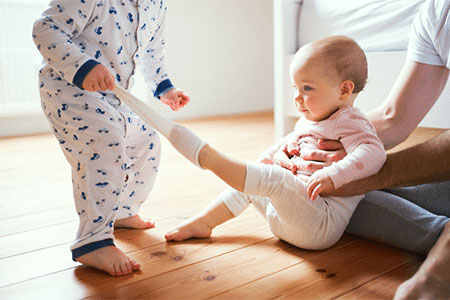
Babies move their toes as a way of exercising their feet, which means that it’s really important to not constrict this movement. Seamless socks allow babies to freely move their toes even when wearing socks.
Getting the correct sock size has the same importance as getting the correct shoe size. If you provide your baby with a pair of socks that are too small, you can constrict toe movement and make your baby’s toes overlap and rub against one another. There is another article that describes the best seamless socks for babies.
Third Step: Washing and Drying your Baby’s Feet
It’s really important to maintain good hygiene to prevent your baby from getting fungal infections. Always make sure that you wash your babies’ feet and that you dry them thoroughly to prevent any trapped moisture.
If you follow these 3 steps you will be keeping your baby’s feet healthy!
I am always asking parents to keep an eye on any signs of abnormal walking gait. This involves walking with the feet turned inwards or outwards. Your child’s walking gait will tell you whether your child might have a foot condition such as flat feet, rolled ankles, or overpronation.
Are Any Other Shoe Choices Available?
Do not hesitate to contact me directly if you believe your child might have a foot condition, I always encourage parents to be proactive and not take the “wait and see approach” when it comes to treating their children’s foot conditions. My email address is:
I am always emphasizing to parents how it doesn’t matter how narrow or wide their child’s feet are, there is always at least one particular shoe style out there that will accommodate the shape of the child’s feet, and I will help you find it.




















